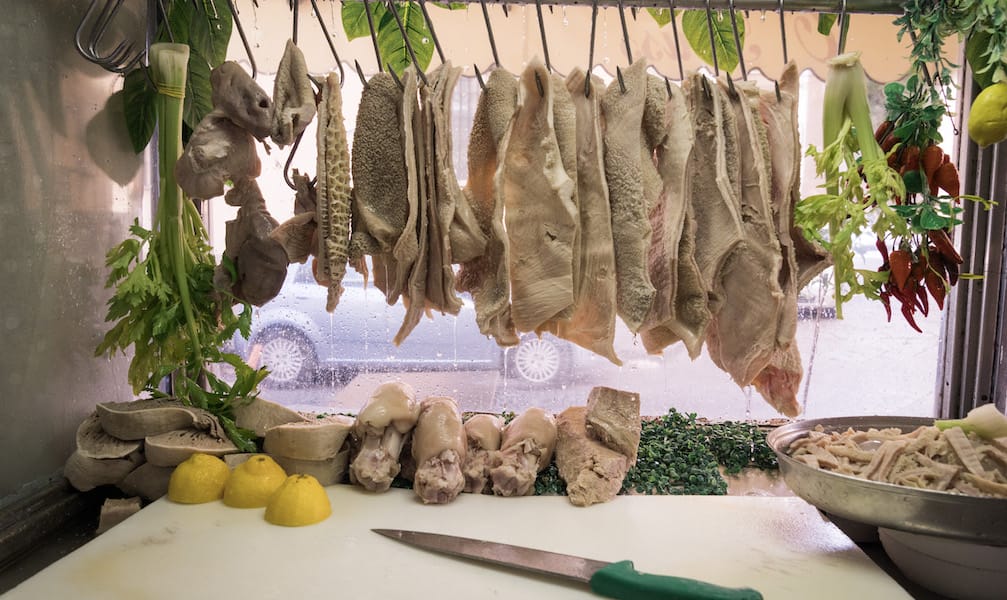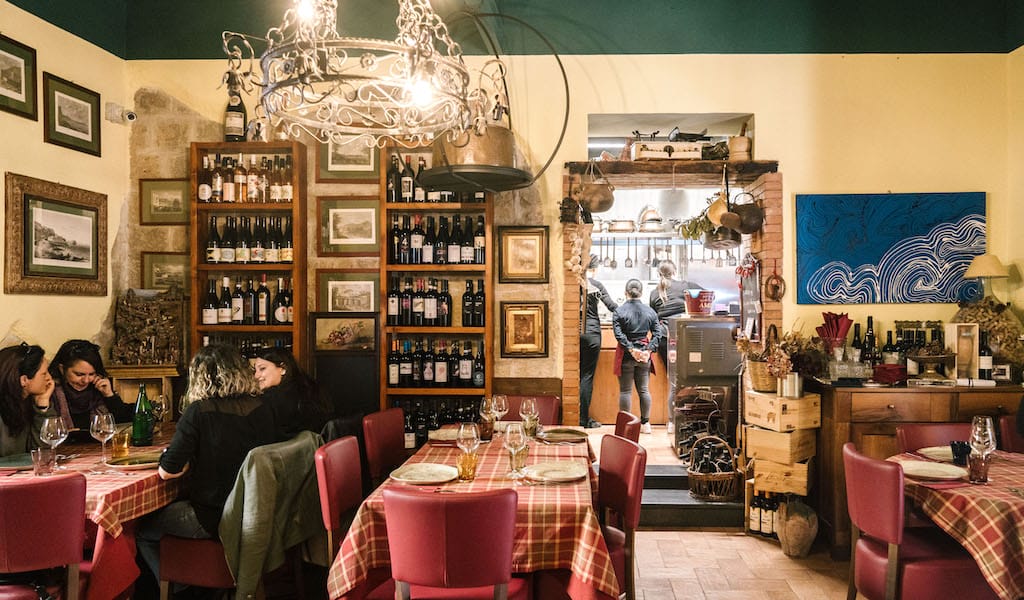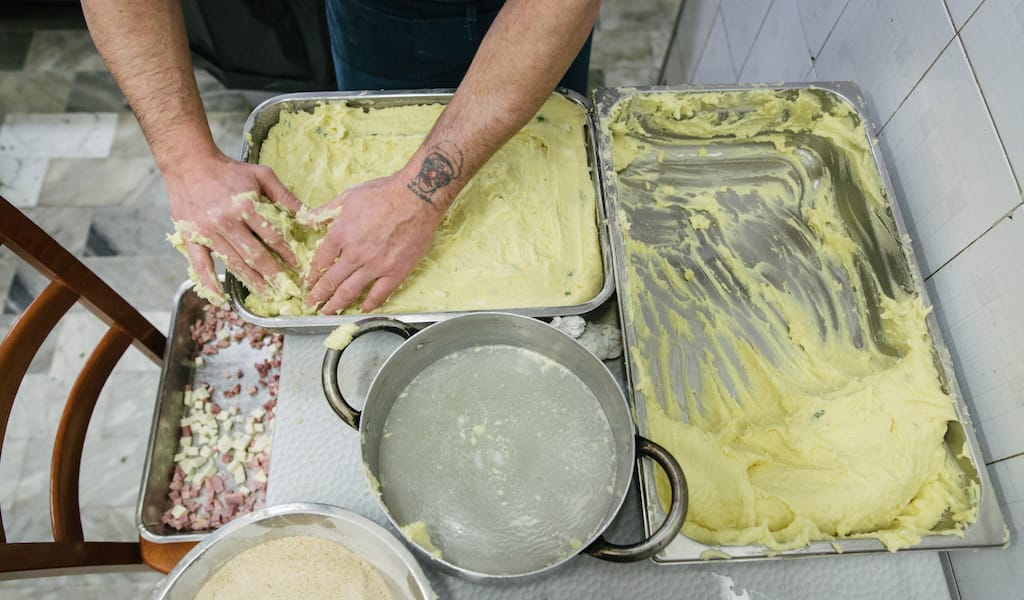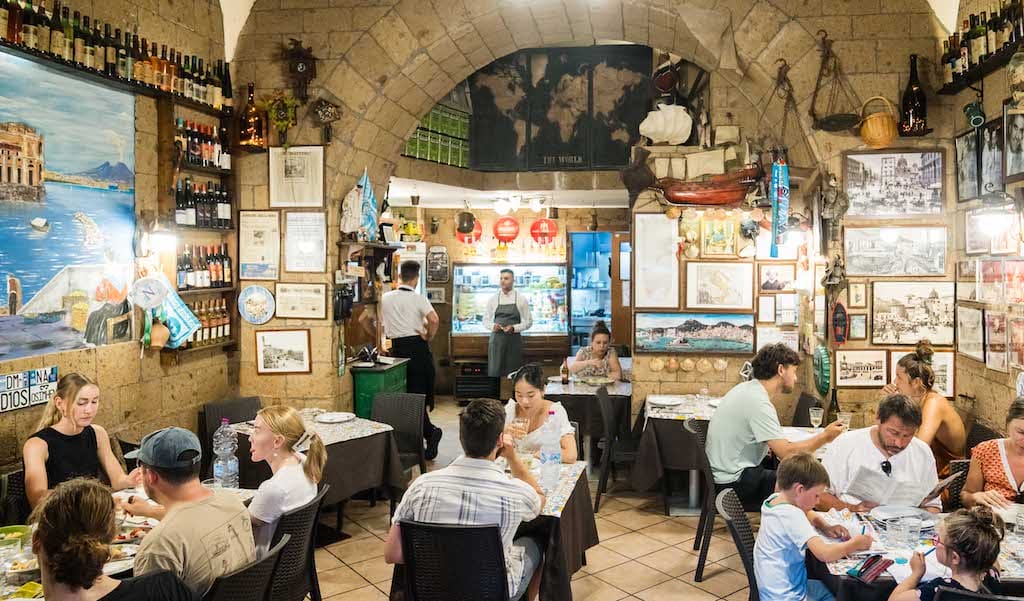In a city like Naples, where almost every kind of street food – or food in general – seems to be carb-and-calorie laden, there’s one unexpectedly light, all-protein option: ’o per’ e ’o muss’.
This tongue-twister dish has roots in the same food traditions common to many Italian regions: back in the 18th century, the needy would save scrap pieces of meat discarded from the nobles (until they, too, realized how good they could be), to make tasty and nutritious recipes out of them.
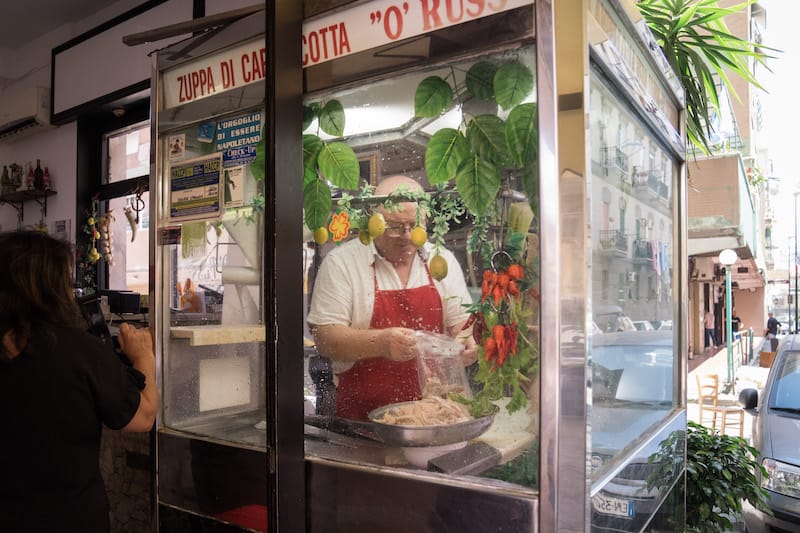
In Rome, for example, this led to the substantial repertoire of quinto quarto (literally, the “fifth quarter” of the animal), recipes in which rich sauces tend to disguise the offal’s taste and shape.
Meanwhile in Naples, this took – at least, partially – a surprisingly lighter twist, with pork’s trotters (pere) and heads (musso) simply boiled and then cut into translucent, gelatinous chunks. Later on, as hard times began to lift, bovine parts were introduced as well, namely heads and tripe. In the postwar period, the cheap cuts – well-cleaned and shaved – were boiled for hours in huge cauldrons in the courtyards of the city’s suburbs, then carried to Naples and sold across the streets by peddlers with their carts adorned with tripe and lemons. Such a sight was common until a few decades ago, when the carts were substituted by more hygienic kiosks with running water and controlled temperatures. But the striking display of citrus, celery, hooves and different kinds of tripe hanging from the hooks can still be seen through glass windows partially opened onto the street, and you can still enjoy ’o per’ e ’o muss’ at places like Tripperia O’Russ.
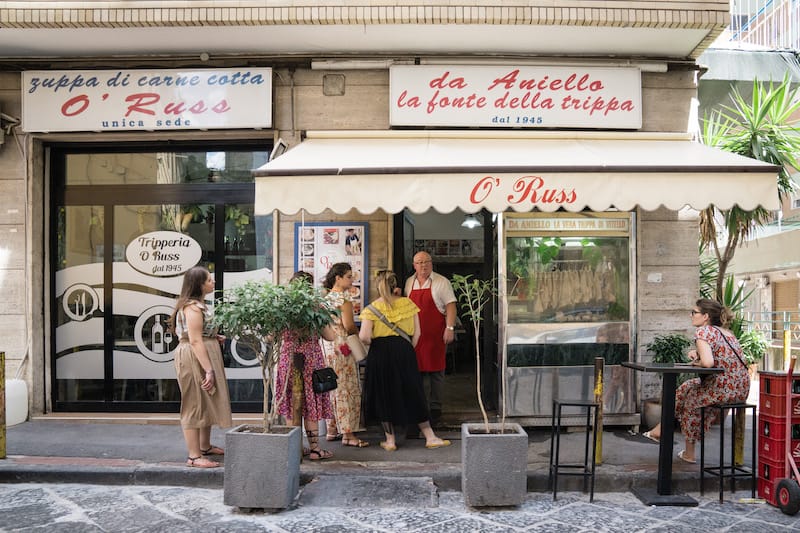
Since 1945, Aniello Daniele had been selling ’o per’ e ’o muss’ – in Neapolitan slang it translates into “the head and the muzzle” – with his cart near Piazza Carlo III and the magnificent Bourbon Hospice for the Poor, built in the 18th century as a facility to house the destitute and ill and which today hosts cultural events. In 1978, Aniello and his family established a proper shop, which eventually became a simple restaurant that also served hot dishes. And, in 1994, they moved to the current location, naming the eatery after his son Vincenzo.
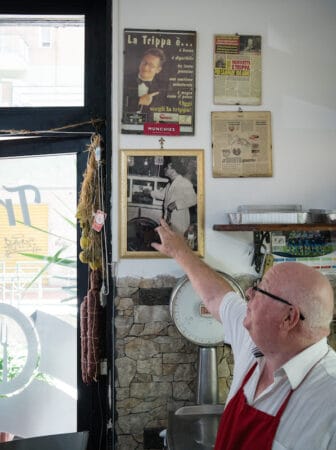
Yes, the bald man with thin glasses and a genuine smile, working behind the bar to refresh and cut veal tripe, feet, and heads, once sported a full head of red hair, hence the name O’ Russ, “The Red One.” As a kid, Vincenzo would go with his father to work the cart and started cutting and selling ‘o per’ e ‘o muss’ at age 12. Nowadays, his daughters and his son-in-law, Marco, help him at the family restaurant, cooking and serving the few tables in the simple room whose walls are covered with pictures of Naples and its venerated icons from as Totò, the famous black-and-white film actor, to San Gennaro, the holy patron of the city.
Vincenzo prepares his delicious mix all day long: he expertly cuts the pieces and seasons them simply with lemon juice and salt, served cold. He serves ’o per’ e ’o muss’ in the foil containers which replaced the iconic wax paper cone once commonly used for this all-Neapolitan street food, making it a perfect takeaway option or even a snack to eat on the go, at very reasonable prices. The dish includes several veal parts, despite the name: the chewy foot, the lovely pink-shaded, meaty head, the “normal” tripe and the honeycomb tripe with its elaborated texture and weave, the rare udder and the very special callo, a particularly exquisite piece of tripe.

The full menu, however, is wide – unconcerned with the turn of the seasons, it always includes a variety of both lighter and more robust dishes. Among the former, the lovely trippa alla Buonocore is a bright and delicate tripe salad which gets its name from a loyal customer who, back in the eighties, would invariably ask to add celery and carrots to his plate. “We satisfied his request, then added some more ingredients to make it even more complete,” Marco recalls, listing olives, tomatoes, and lupini beans, a much-loved snack in Naples and the surrounding area. Together with the spaghetti with tripe and potatoes, enriched by a generous amount of grated cheese, this is a summer favorite.
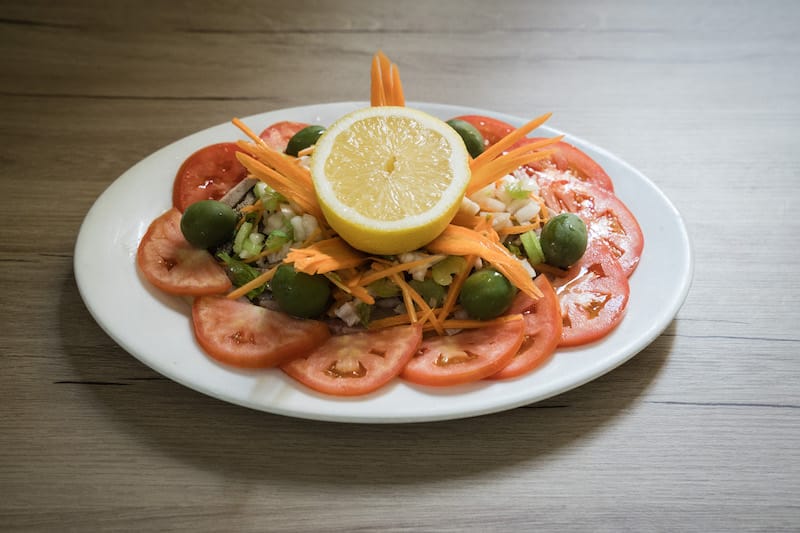
Then we have the zuppa di carnecotta (cooked meat soup), an intense tripe broth once a popular meal among the poor, to which they added the color of tomato and the scent of fresh herbs, served with toasted bread, cheese, and black pepper or chili pepper. Apparently, this is a favorite both among Neapolitans and visitors from China: “There is a similar recipe which is a staple of their food culture: thanks to word-of-mouth, they come here showing pictures and ask for carnecotta!” Marco tells us, referring, likely, to dim sum tripe stew. At O’ Russ, tripe is also cooked and served with potatoes, with beans, or in the traditional version with a delicious tomato sauce to mop up with bread; and, for those who can’t decide, there is the “tris” with a bit of each in a three-compartment plate.
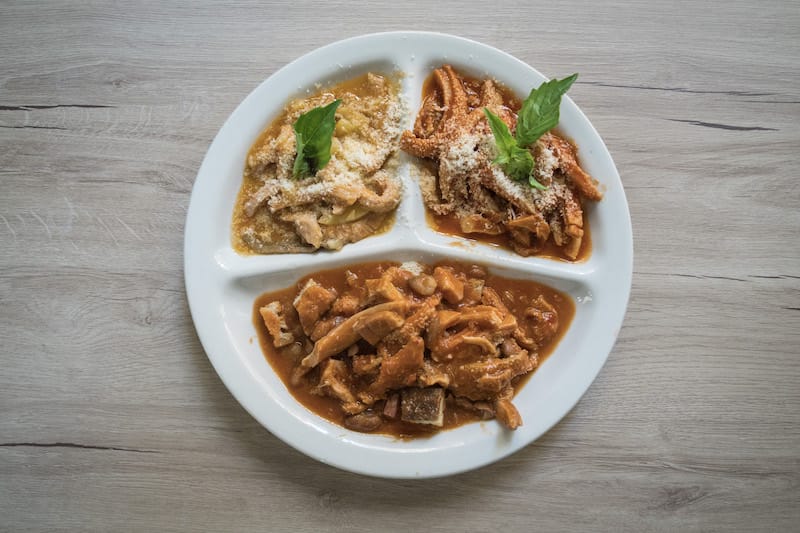
A year-round must-try is the vibrant spaghetti con soffritto, a generous pasta dish seasoned with the rich red sauce also called zuppa forte (spicy soup). While usually in Italy the word refers to the mixture of finely chopped onions, celery, and carrots sautéed in olive oil, a recurring base for many national recipes, this soffritto, instead, is made with tomato and pork’s offal such as heart, tongue, and lung, each of them giving a definite texture and taste: a sublime ensemble of rustic elegance and boldness, perfectly held together by the spiciness of chili pepper and the scent of bay leaves. Not a dish for everyone, certainly, as is the case for tripe in general.

This is why, Marco explains, here at O’ Russ – as well as in many other tripe restaurants in Naples – it’s common to find more comforting plates as well, such as pasta with Amatriciana sauce (a stronghold of Roman cuisine based on tomato, hog jowl bacon and cheese) or the odd Mexican-style beans, an easier twist on the classic tripe-and-beans duo adapted to please a broader clientele and include even the pickiest eaters. We look around in the room, searching for confirmation of this meek ordering – a feisty group of elderly locals and a family with two sons are here eating their dinner. Our search was in vain: even the kids, around ten years old, are digging into huge portions of tripe and soffritto.
 November 6, 2023 Buatta
November 6, 2023 Buatta
Chef owner Angela Gargiulo calls her restaurant Buatta a trattoria di conversazione – a […] Posted in Naples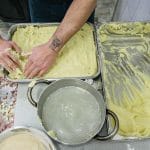 October 10, 2023 Cibi Cotti Nonna Anna
October 10, 2023 Cibi Cotti Nonna Anna
Neapolitan cuisine is an impure thing, the result of culinary influences from every part […] Posted in Naples August 14, 2023 È Pronto ‘O Mangià: Come and Get It!
August 14, 2023 È Pronto ‘O Mangià: Come and Get It!
In Neapolitan dialect, “È Pronto ‘O Mangià” means simply: “Food is ready!”
It is the […] Posted in Naples
Luciana SquadrilliGianni Cipriano and Sara Smarrazzo
Published on September 29, 2023
Related stories
November 6, 2023
NaplesChef owner Angela Gargiulo calls her restaurant Buatta a trattoria di conversazione – a “conversation eatery.” Tucked in a peaceful corner of Vomero, the Neapolitan shopping district, Buatta is “…a conversation restaurant in the true sense of the word,” Angela tells us. “After cooking, and now that I have excellent collaborators [to help] in the…
October 10, 2023
NaplesNeapolitan cuisine is an impure thing, the result of culinary influences from every part of the old continent. One of the most famous dishes this cross-pollination has produced is the Neapolitan potato gattò, a potato tortino rustico (a tall, square cake) with layers made of mozzarella, scamorza, ham, salami and more. A baroque dish, this…
August 14, 2023
NaplesIn Neapolitan dialect, “È Pronto ‘O Mangià” means simply: “Food is ready!” It is the perfect name for Mattia Grossi’s trattoria, a small, unassuming space on via Cesare Rosaroll. We are welcomed to this family-owned restaurant with an undeniably warm atmosphere: stone walls lined with old photos and newspaper clippings, smiling waiters, music and chatter.…







































